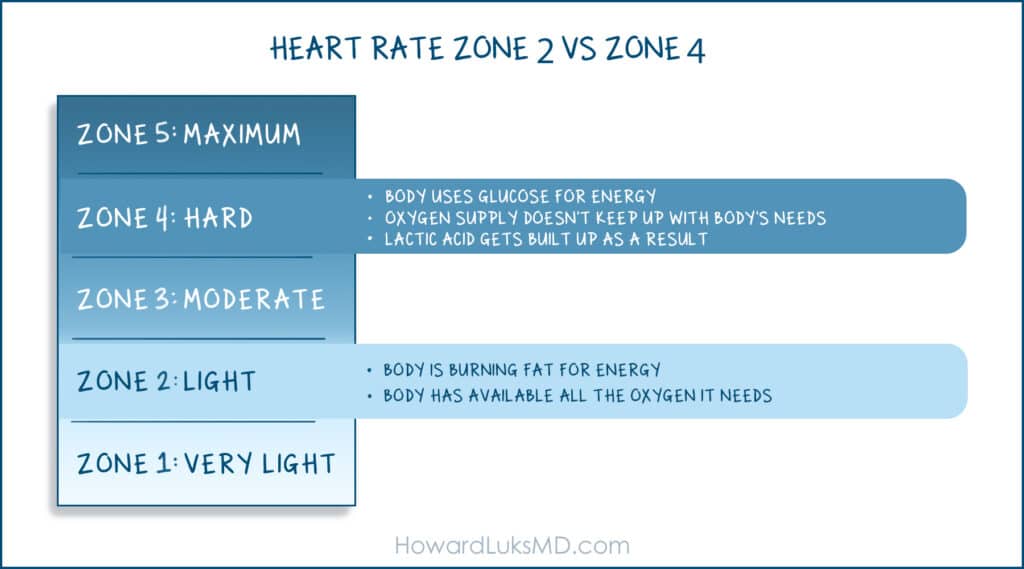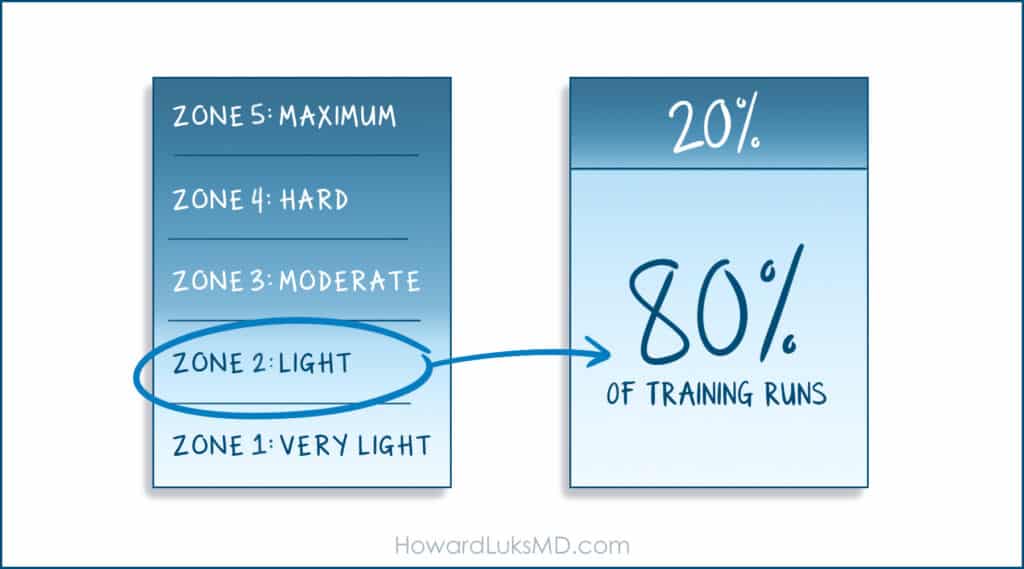
Whether you are optimizing your exercise regimen for performance or you want to live a longer healthy life, the concept of zone 2 heart rate training deserves your attention. There is a lot of confusion online about zone 2 or low heart rate training. There are many myths and unsubstantiated claims out there as well. This article will help by providing evidence-based information about low heart exercise benefits, and we will help dispel some of the myths that are common in social circles. This post will concentrate on the importance of Zone 2 training and the science behind it.
“Train slow to run fast”. The training regimens of some of our greatest athletes can teach us a lot. The science behind Zone 2 training illuminates why this is true. Zone 2, or low HR training, is also one of the best tools to achieve metabolic health and longevity. Low heart rate zone 2 cycling, swimming, rowing, and running are also key to improving performance and minimizing the risk of developing stress-related injuries.

This post is for athletes looking to improve their training and performance, and it is also for non-athletes who want to live longer healthier, more active lives.
Why is Zone 2 training important?
Whether you are training or you are trying to lead a healthier life, improving your mitochondrial number, efficiency, and metabolic flexibility should be your focus. We will cover each of these concepts in detail. Low heart rate, or zone 2 training, is one of the best ways to improve these mitochondrial parameters.
The average runner runs too fast on their slow days and too slow on their fast days. They think they need to push hard to build endurance. They think they need to feel exhausted or stressed at the end of a long run. The reason why this isn’t true is simple. Your physiology. You need to consider what is happening inside your muscle cells in each heart rate zone (which we will discuss in a bit). Training under your zone 4 ceiling will not improve your zone 2 ceiling. Physiologically speaking, we are dealing with two very different energy systems. One occurs inside the mitochondria, and the other inside the cell’s cytoplasm. In other words, training in Zone 2 improves all zones above it (3-5). Training in higher zones does not improve lower-zone fitness.
Not only will Zone 2 heart rate training boost your performance, it just might save your life. Humans die of very predictable causes. Most of the chronic diseases that will lead to our demise have a common root cause– poor metabolic health due to poor mitochondrial function. Exercising in Zones 1 and 2 will improve your mitochondrial number, function, flexibility, efficiency, and fitness. Exercising in zone 3 and above will not improve your aerobic (mitochondrial) health as well, but as we will cover, it does have its role.
Zone 2 training can have a dramatic impact on our overall health. It does so by improving metabolic fitness and flexibility. Both of which are topics I cover extensively in my new book, Longevity Simplified.
Wendy was a stellar runner and cyclist. On the trails every Sunday, she always merged with the group out front. I might have been able to catch up to them, but I wouldn’t have been able to speak. On the road, she powered up hills like they were non-existent. She pushed 300 Watts on her bike like I pushed 200. She was also a competitive triathlete. Then came February…

Peloton! Your new bike arrives. It looks sleek. You put your water bottles in the holders and jump on. You choose a class and pound out a 30-minute heart-thumping ride. You repeat this a few times a week. Certainly, this is good for your health, right? Yes, there are benefits to HIIT-style training, but… The importance of base training or zone 2 heart rate (HR) training has fallen by the wayside for far too many of us. Our society loves quick, hard challenges. We gamify everything… you watch the leaderboard and want to move up further. Zone 2 HR training is hard… but the payback is worth it.
What is Zone 2 Training
To understand what Zone 2 training is and why Zone 2 training is important, we need to start with some basic physiology. Zone 2 training will have an impact on our metabolic health…but first, we need to learn about our mitochondria!

Read: How does your metabolic health affect your body and joints?
Mitochondria are the key to a healthier life and better performance.
Mitochondria. We are taught that they are the powerhouse of our cells. Mitochondria are so much more, but we’ll get to that later. We assume mitochondria are like an engine; give them fuel, and they work. Well, they are, sort of. However, like a fine race car engine, they require your attention to work in peak condition. The healthier your mitochondria are, the healthier you will be. Poorly functioning mitochondria, or “mitochondrial dysfunction,” is seen in people with heart disease, dementia, Type 2 diabetes, Metabolic Syndrome, cancer, and so on.
Mitochondrial dysfunction is also a root cause element of insulin resistance. Insulin resistance is the predecessor of type 2 diabetes, and it is also present in people with metabolic syndrome. Insulin resistance and the chronic inflammation that often accompanies it also contribute to our risk of developing atherosclerotic heart disease, strokes, kidney damage, blindness, dementia, cancer, and more. Nearly 40% of people have insulin resistance, so this is a subject matter we need to pay attention to.
Scientists are now finding evidence of mitochondrial dysfunction nearly 5-10 years before those changes will manifest as something like Type 2 Diabetes that your doctor can find on your blood tests. Researchers have found that sedentary college students are insulin-resistant. When it comes to mitochondria, the issues we care about are:
- the number of mitochondria you have.
- the metabolic “flexibility” of your mitochondria- in many diseases, the mitochondria can only process glucose and not fat. This “inflexibility” leads to significant downstream effects.
- Mitochondrial efficiency. How well do your mitochondria process the various substrates– glucose, fat, and lactate to produce energy or ATP?

Wendy hit the trails on a bright, chilly Sunday in February. But this day was different. She stayed near the back of the pack. Hills made her more short of breath than usual. Perhaps it was just one of those days.
Zone 2 Heart Rate Training…
Sometimes, I rail against Peloton and other platforms that push us harder each day. I want to stress… I am not against HIIT training. Let’s call it a “concern” about how frequently you do it. By working out too hard, too often— overtraining is a very real possibility and a difficult problem to contend with once it’s present. Along with overtraining comes an increased risk of injury. Recovery from injury takes a toll: emotionally, physically, and physiologically. I discussed how profoundly a long recovery can affect us here… it is something to be avoided, if possible.

Goals, Longevity, and Zone 2 Training.
Many of us want to improve our athletic fitness, endurance, and performance. Face it, we also want to live longer, and with fewer health problems. That’s where Zone 2 training comes into play. Zone 2 training involves training at a lower intensity for a longer period of time. We’ll get into how to determine when you are in Zone 2 later on. For now, we are going to explore the benefits of proper training and the downsides of ignoring Z2 training.
Zone 2 training is also referred to as base or aerobic training. All elite athletes spend months base training. At least 75-80% of their active training is also in Zone 1 or 2. This is what we refer to as polarized training. Let’s not assume we know more than those who train these world-class athletes.

Benefits of Zone 2 Heart Rate Training.
- Increase in the number of mitochondria
- Increase in mitochondrial efficiency
- Increase in “metabolic flexibility”
- Lower resting heart rate
- A decrease in blood pressure
- Lower risk of injury
- Improves insulin resistance
- Improve your ability to run/cycle longer
- Improve your resilience and ability to deal with increasing load
- Improve your Zone 4,5 function/performance
- Improved longevity
During Zone 2 training, you will increase your number of mitochondria, mitochondrial efficiency, and increase your metabolic flexibility. Metabolic flexibility refers to the ability of your mitochondria to utilize fat (fat oxidation) and glucose (glycolysis) as an energy source (substrate). At low heart rates, your main source of fuel should be fat… not glucose. Poorly functioning mitochondria, which are likely to be found in ~ 75% of people, will result in metabolic inflexibility.. or the inability to utilize fat versus glucose.
People who are poorly trained, sedentary, or those with insulin resistance, Type 2 diabetes, and Metabolic Syndrome (hypertension, abdominal fat, insulin resistance [high A1c]) are very poor at using fat and often go straight to glucose as a fuel source very quickly with walking. This is the picture of metabolic inflexibility. This produces excess lactate, and due to poor mitochondrial function, their clearance of the lactate is poor, and the lactate builds rapidly. Accompanying lactate is a hydrogen ion. That hydrogen changes the pH of its local environment, in this case, skeletal muscle, and that produces weakness and exhaustion. In addition, there is a fair amount of literature showing that chronically elevated levels of lactate have very significant consequences on our health, and increases our risk of developing many different cancers.

Zone 2 heart rate training, by improving mitochondrial flexibility, enables you to use fat as an energy source for longer and more efficiently. Thus, you preserve your glycogen (glucose) stores for longer. Glycogen gets broken down into glucose, which serves as your fuel source for higher-intensity efforts. One end product of using glucose is lactate. Now, lactate isn’t as bad as you think it is. In trained individuals, they can shuttle the lactate back into the cell and use it as fuel! That requires an active transporter… MCT-1. The more Zone 2 exercise you perform, the more of that transport protein you will make. That improves your ability to clear the lactate. The mitochondria will take the lactate in and use it as fuel.
Perhaps even more important. Mitochondrial health is critical to longevity. Many diseases that affect our lifespan are considered to be due to metabolic dysfunction. Mitochondrial dysfunction is relevant to cancer growth, immune system function, dementia, heart disease, type 2 diabetes, and much more. As I mentioned, this is precisely the reason why I wrote Longevity Simplified… there are simple strategies to improve our chances of living longer. No rabbit holes are needed.
Zone 2 heart rate training optimizes your muscles’ mitochondrial function.
When functioning well, our mitochondria use fat, glucose, and lactate as fuels. In Zone 2 you should be using fat oxidation as your primary source of fuel for energy production. In our muscles, we have Type 1 or slow-twitch muscles, and Type 2 or fast-twitch muscles. Type 1 fibers have plentiful mitochondria and prefer fat as their source of energy. Type 2 fibers are glycolytic… meaning that they burn glucose. Burning glucose produces lactate. Lactate can be used as fuel if you are well-trained. In others, lactate, and an accompanying hydrogen ion build up. It’s the hydrogen that’s the reason we become exhausted.
The hydrogen ion will change the microenvironment around the muscle cell and make it far less powerful. You can lose more than 50% of your muscle power as hydrogen builds up. That is the hallmark of fatigue. Now, fatigue is more complicated, because there is central, or brain-related fatigue and muscle fatigue, but that’s s topic for another article.
In Zone 2 training, we want to be firing all our Type 1 fibers and not fire or use our Type 2 fibers. We do not want lactate to build up. There is always some glucose being burned… so lactate will rise a bit in zone 2, but it should rise to a point and stay there. This equates to you feeling like you can maintain your efforts for a long time. Once you recruit your Type 2 muscle fibers, you will start to fatigue. The rate at which you fatigue is variable. That rate will depend on how well trained you are, and how well your mitochondria clear the lactate. The reason why you can maintain low heart rate efforts for a long time is that we have an infinite source of energy available to us in terms of our fat stores. The same is not true about our glycogen stores.
Zone 2 training even improves your faster training.
With polarized training, 80%+ of your training is completed in zones 1 or 2. The harder efforts or the 20% are important too. As I discussed here, the best way to improve your lactic acid threshold performance is with a strong aerobic base. The only way to build a strong aerobic base is with months of base training in zone 2. Training more in higher zones isn’t going to improve your overall performance as much as your lower HR efforts. Once you cross the ceiling of zone 2 you are burning more glucose (glycolysis); this will cause your lactate to rise. Well-trained athletes can “shuttle” that lactate back into the mitochondria to use as fuel. How can you build that shuttle’s capacity? Correct, zone 2 training. Lactate, the lactate shuttle, and the science behind lactic threshold training are discussed in this article.
What is Zone 2 Running?
Simply put, zone 2 running is an “easy” run. You can talk during the run, you can breathe through your nose during the run. It is a pace that is slow enough to allow you to stay in your Zone 2 heart rate target zone. If you live in a hilly area, you may find that you need to walk those hills at first to maintain your heart rate in Zone 2. Some very well trained runners need to run pretty hard to stay in zone 2. For the rest of us, we need to slow down to stay in zone 2, but as your aerobic base becomes stronger, you will be able to run faster and longer while staying in Zone 2.
Why is Zone 2 running so hard?
Zone 2 running is “hard” because most people find it very challenging to stay at a slow pace for a long time. 45 minutes should be the minimum time that you should aim for. Until your aerobic base (and mitochondria) are better trained you will find that you have to run at a painfully slow pace and walk many hills. If you stick with it, you will be able to achieve a faster pace, yet be able to stay in Zone 2.
Remember, it is important to stay in zone 2 during the entire run. If you try to run hills, or try to run too fast and your heart rate enters Zone 3 or higher then your mitochondrial physiology is changing. You are starting to use glycolysis more than fat oxidation. You are no longer training your mitochondrial aerobic base. Even if you slow down, it will take a while for your cells to return to fat oxidation and recover from the lactate that built up from your higher heart rate effort. This is why it is important to walk at times. Trust the process… eventually, you will be able to run those hills and stay in Zone 2.
How do you know when you are in Zone 2?
Until recently athletes needed to go to a performance lab, or stick themselves to measure lactic acid to try and determine where they transitioned from aerobic (fat oxidation) to Zone 3 and above. That transition point goes by many names. We’ll call it the first lactic acid threshold or LT1. Anything below your LT1 is considered aerobic. You are mainly using fat oxidation for energy production in this zone.
For performance athletes and high level endurance athletes, it is well worth your effort to go to a performance lab for a professional determination of your LT1 and LT2. These will precisely determine when you transition in and out of Zone 2.
Read: Polarized or 80/20 Running: Train Slow To Run Fast
Methods to calculate your Zone 2 heart rate.
Heart rate: When you are in Zone 2 your heart rate is somewhere between 65-75% of your maximum heart rate. Using your heart rate (HR) is probably your best way to identify what zone you are in. For an accurate assessment, we need to know your maximum HR and your resting HR. I’ve hit my max HR on some trail races- a most unpleasant experience! Your resting HR is your HR in bed as soon as you wake up and before you get up.
The old method of calculating your maximal heart rate using 220- your age is not accurate for many people and should not be relied upon unless you only need a crude estimate. For those of you who know your maximum HR and your resting HR, Training Peaks and many other calculators are out there and can help you figure out your zones.
70% of your “heart rate reserve” is a great estimate of the upper bounds of your Zone 2. If you choose to use approximately 70% of your heart rate reserve… here’s the formula. 70% of your heart rate reserve added to your resting heart rate (so your aerobic threshold would be 0.7(HR max — HR at rest) + HR at rest. In my case, 0.7(178–48)+48 = 139 beats per minute)
Using DFA-Alpha 1 (discussed below) my upper zone 2 HR calculates out to be 132-134. I have gone through the process of making sure that my DFA-alpha1 measurements are concordant or correlate with my heart rate calculations as well as blood lactate testing. Recent research (late 2021, early 2022) shows that just using DFA-alpha 1 isn’t always accurate— there can be many outliers.
With respect to your “perceived effort”, near the top end of zone 2, you may find it a little harder to hold a conversation without having to pause to breathe. On the contrary, if you only use breathing and perceived effort to determine your zones, you may find that you’re exercising too often in Zone 3. It’s not uncommon on long hilly runs with friends that I have a HR up to 151 and we are still chatting away.
The benefits to our health and our progress as athletes come with long zone 2 efforts. You do not want to let your heart rate leave zone 2. When that happens your physiology changes. Your cells are switching to anaerobic pathways and you are making enzymes and compounds to allow for a higher level effort. Even if you slow down and your heart rate goes back into zone 2, it will take a while for your physiological processes to revert back to fat oxidation. The benefits of zone 2 training come from staying in zone 2 the entire time. Hopefully for a 60-90 minute workout. If you want to tack on some sprints or hills to a long workout, do it at the end of your zone 2 training.
Breathing: If you can speak easily and in full sentences without having to pause at all you are probably in Zone 1 or 2. If you can breathe through your nose for the entire run, you are likely in zones 1 and 2. If you can speak or sing, but need to pause occasionally to breathe you are probably in Zone 2. If you cannot speak more than a few words before you need to pause, you are in Zone 3 and above. The above may hold true for most people. But as I alluded to earlier, for many of us, we are still capable of holding an uninterrupted conversation well into zone 3. By all means, if you can “hear” yourself breathe, you are not in zone 2.
If you really pay attention to your breathing you will notice an inflection point. That is, you will notice that you take a deeper breath every so often, or open your mouth to take a deep breath. You should be able to identify this inflection point during your workouts. At that point, you are at the high end of zone 2.
Elite athletes are tested extensively to determine precisely when they are in zone 2. You and I do not have easy access to those labs. When elite athletes are in a lab they will measure their lactate to see when it starts to transition upwards after an initial plateau. The scientists may also study their respiratory quotient (RQ). That is a calculation that is based on expired CO2 to determine what fuel they are burning. A respiratory quotient of 0.7 and you’re burning more fat, an RQ of 1 and you’re burning all glucose.
Do you have questions regarding an Orthopedic injury or longevity?
Do you want to talk to an expert who can listen to you for 45-60 minutes and explain the options in detail?
Dr. Howard Luks offers remote guidance sessions to review your X-ray or MRI images and explain your options.
Dr. Luks has also received hundreds of requests for educational sessions on the topics discussed in his book, Longevity Simplified.
Cardiac Drift: Let’s spend a moment talking about Cardiac drift. Cardiac drift will occur for most of you near the end of a long run or ride. That means that your HR starts trending up despite holding the same wattage on the bike or minutes/ mile during a run. Dehydration can drive cardiac drift… but more likely in non-elite athletes, cardiac drift is due to metabolic stress. You are leaving Zone 2 and using more Type 2 muscle fibers. Those Type 2 fibers burn glucose and produce more lactate. The lactate causes your muscles to be less effective and consequently, you need to work harder to maintain the same effort.
What do you do if you see your heart rate drifting? As you drift, adjust your effort to maintain the same heart rate. Don’t keep up the same effort. As your training improves your metabolic flexibility, mitochondrial efficiency, as well as your muscles’ ability to clear lactate will improve. As your training and fitness level improves, you will notice that the time when you start to drift will also improve.
DFA-Alpha1: HRV Logger App. The science behind using DFA-Alpha1 is very complex… This technology is available to everyone with a heart strap (preferably Polar) and a smartphone. Your HRV or heart rate variability is considered to be a barometer of your parasympathetic nervous system activity. By detecting these changes, you can calculate the DFA-Alpha1. A DFA-Alpha1 value of 0.75 or above correlates with zone 1 or zone 2 heart rates. A DFA-Alpha1 of 0.75 MIGHT be your first lactic acid threshold or LT1. If you want to use the DFA apps, you need to correlate it with your heart rate, breathing, and preferably lactate testing to be sure that your DFA-alpha1 level of 0.75 is an accurate predictor of your upper level of zone 2.
Our latest Podcast on Mitochondrial health and longevity.
How long should I stay in Zone 2?
How much exercise is needed to improve Zone 2 fitness? These professional coaches suggest that 90-minute sessions are needed. If performance is your goal, then preferably twice a week. For those who are pressed for time… try to ride 75-80 minutes in zone 2 then crank it up for some sprints at the end of the ride. In terms of cardiac health, short high-intensity sessions are also important. Many find it easier to perform these higher intensity sessions at the end of a long Zone 2 effort instead of doing them on a separate day. Our VO2 max also contributes to our health, but perhaps not as much as having a solid aerobic base which can only be built with many months of mostly Zone 2 training.
Read: Training Errors and Injuries in Runners
Wendy came out the following Sunday. But she hadn’t been able to ride or run all week. She felt rundown. We sat in the parking lot and discussed this before the rest of the group took off. She wasn’t going to push it that day. Turns out, she only made it one mile. The next day she was in my favorite Cardiologist’s office.
What is Overtraining?
Training hard seems like a logical way to proceed if your goal is to increase performance, and perhaps your lifespan. When most runners notice that their time/mile is increasing, or their heart rate at a certain pace is higher than usual, they often push harder… but this is a recipe for poor performance. You’re “overreaching”… the first stage of overtraining. If you monitor your heart rate, you see that your resting heart rate is increasing. Your heart rate variability will likely be dropping. Your body temperature is elevated. If you have a Peloton you notice that your wattage is decreasing.
Recovery is a weapon.. respect your body’s need to rest

What are the warning signs of overtraining?
Some of the more obvious signs of overtraining include:
- fatigue
- increased soreness
- you’re less than enthusiastic about training today
- moodiness: you may be more depressed or angry
- your motivation lags
Physical manifestations and warning signs of overtraining include:
- You don’t feel well.
- Increased resting pulse or blood pressure
- weight loss
- Gastrointestinal issues such as constipation.
Please Avoid Overtraining:
- Going hard every workout will increase your risk of injury. Stress fractures and various tendinopathies will occur more frequently when overtraining.
- Overtraining can be a problem for weekend warriors as well as professionals. Some of you, maybe even most of you won’t be able to recognize that you are overtraining until it’s too late.
- Overtraining doesn’t necessarily result in sore muscles… it results in higher resting heart rates, higher basal body temperature, lower heart rate variability (HRV), and a gradual decline in your performance. At its worse, it starts to affect your mood, your immune system, and even your desire to exercise. Overtraining has ruined the career of many athletes.
- In the past, 20-40 years ago, a watt was considered a watt… so coaches just pushed people… hard. And then we started to follow certain physiological and performance parameters like those mentioned above and we started to see overtraining and its manifestations: illness, burnout, and injuries.
- Over the long term, chronic overtraining and overexertion can lead to permanent heart damage.

Many elite training programs use a polarized training mix of 80/20. 80% of training is in zone 2. 20% are harder efforts- therefore, threshold or VO2 max levels. Surely these trainers and sports physiologists know a little more about training than us?
Training too hard and too often might actually take years off your life
Wendy’s tests revealed that she had a dilated heart. Another test also revealed an arrhythmia… an abnormal heart rhythm. This was one of those arrhythmias that result in a higher risk of death. So, Wendy, had a defibrillator placed. That would shock her heart if she needed it. Wendy hasn’t needed her defibrillator yet… but she also isn’t able to exercise aggressively. Her heart is too weak.
Your heart is a muscle. It can wear out. Let’s assume you have 3-4 Billion beats in your heart before it tires out. That’s one reason why folks with lower heart rates live longer. Drive your car less it and you’ll keep it longer too.
The Reverse J Curve of All-Cause Mortality Benefit From Exercise:
Current studies suggest that 2.5 to 5 hours/week of moderate or vigorous physical activity will confer maximal all-cause mortality benefits. But studies dating back decades have shown that more than 10 hours/week may reduce those health benefits. This is known as the reverse J curve of exercise. The most physically active among us in middle age have a predicted life expectancy eight years longer than those who are more sedentary. But the proper “dose” of exercise is critically important.
There are large improvements in the risk of all-cause mortality (ACM) for people who manage to walk 6,000 steps per day. Your ACM risk continues to decrease to a certain point. Say around 15-20 miles per week for runners. This assumes that you’re not running at your lactic threshold the entire time. After 10-15 miles/week, you begin to lose some of the ACM benefits of exercise. For those who train 50 miles/ week or more, you may give back as much as 38% of the risk of dying from ACM.
Zone 2 heart rate training offers profound benefits for all of us. Regardless of whether or not you plan to PR your next race, or live longer to play with your grandchildren. Overtraining should be avoided. It can have awful short-term and long-term consequences.
It’s very easy to get lost in the weeds if you spend any amount of time reading about how to exercise online. Whether you are optimizing for longevity or performance, zone 2 heart rate training — or base training — offers very significant benefits. Many of the world’s top trainers and athletes follow a polarized training schedule which emphasizes that 80% of your training is aerobic and in Zone 2. Perhaps we should take our queues from the best :-).











